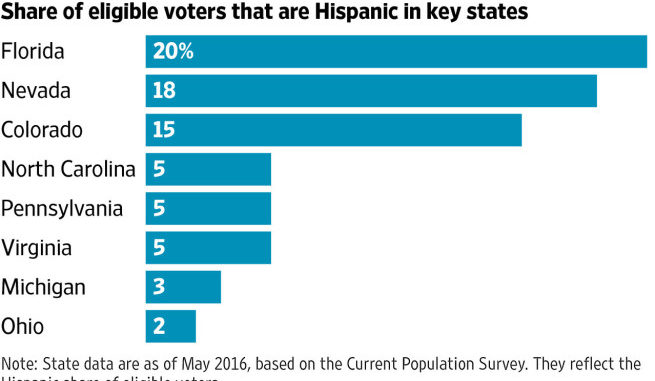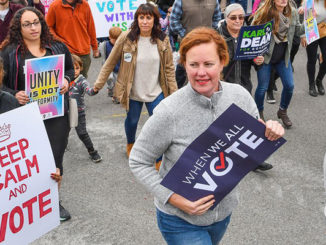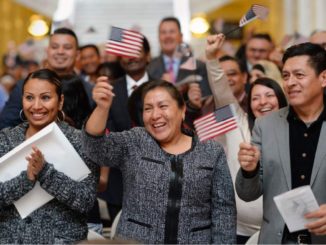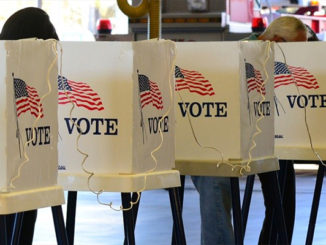
by Beth Reinhard
Republican Donald Trump likely faces higher hurdle in some traditional battleground states and even in Arizona
Hispanic voter registration is hitting record numbers in key states, likely creating a higher hurdle for Republican Donald Trump’s presidential bid in such battlegrounds as Colorado and even in Arizona, which hasn’t voted Democratic for 20 years.
Mr. Trump’s references to Mexican immigrants as criminals, his pledge to build a wall along the southern border of the U.S., and his plan to deport millions of illegal immigrants have left many Hispanics with a negative impression of Mr. Trump.
At a strip mall in this Denver suburb where activists were registering new voters, Paola Jaramillo, an 18-year-old high school senior, said, “He’s no good. He doesn’t want my mom here.” Her mother, who cleans apartments for a living, came to the U.S. illegally from Mexico 20 years ago.
Rafael Aguayo Gomez, 68, a Mexican-American registering to vote for the first time, was blunt when asked about the New York businessman: “Un racista.”
Mr. Trump, who says his policies are driven by national-security concerns and not because he views immigrants negatively, drew 22% Hispanic support in the June Wall Street Journal/NBC News poll, compared to Democratic candiate Hillary Clinton’s 69%. A Pew Research Center poll released last week showed Mr. Trump with 24% Hispanic support versus Mrs. Clinton’s 66%.

That’s lower than the 27% the GOP’s Mitt Romney got in 2012, when he lost to President Barack Obama despite winning 59% of the white vote.
Even if Mr. Trump improves slightly on Mr. Romney’s performance with white voters, expanding his support in the fast-growing Hispanic community is imperative to winning the White House.
“The electorate is only getting more diverse,” said Florida-based Democratic strategist Steve Schale, who worked on Mr. Obama’s 2008 and 2012 campaigns. “If Clinton keeps the relatively anemic level of white support that Barack Obama got in 2012, Trump can only make up the difference by improving with Hispanics. Otherwise, there’s no path.”
Dahlys Hamilton Dela Espriella, an Atlanta resident who belongs to a pro-Trump volunteer group called the National Diversity Coalition, said she thinks the media distorts the candidate’s position on immigration. “The campaign needs to start reaching more into the neighborhoods where there’s a lot of Hispanics,” she said.
What Hillary Clinton May Look for in Her Vice President
Mr. Trump tells his supporters that ultimately he will do very well with these voters. “We’re going to win with Hispanics,” Mr. Trump said in a May visit to New Mexico, the state with the largest Hispanic population.
Mr. Trump’s campaign officials say his economic message will carry the day. “Donald Trump is the only candidate who is going to bring back jobs to America, while Hillary Clinton would be terrible for the middle class, for African-American voters and for Hispanic voters,” said Trump spokesman Jason Miller.
Still, the urgency of Mr. Trump’s mission grows daily as more Hispanics prepare to cast ballots in November.
In Arizona, which hasn’t voted for the Democratic nominee since 1996, a recent poll by OH Predictive Insights showed Mrs. Clinton up by four points. In a clear sign the Trump campaign views Arizona as turf to defend, it is among 17 states identified as top targets.
On a tape obtained by Politico in May, Arizona Sen. John McCain said during a re-election fundraiser: “If Donald Trump is at the top of the ticket, here in Arizona, with over 30% of the vote being the Hispanic vote, no doubt that this may be the race of my life.”
In Arizona, Hispanics will make up 22% of the population eligible to vote in November, according to a Pew Hispanic Center analysis of U.S. Census data. In three of the most competitive states in November—Colorado, Florida and Nevada—Hispanic voters make up growing, double-digit shares of the voting rolls.
Colorado doesn’t sort new voters by race and ethnicity, but nonpartisan voting activists say they are on track to register more Hispanic voters than in previous elections. One group called Mi Familia Vota expects to register 120,000 voters this year in Colorado and five other states, compared to 90,000 in 2012. Fifteen percent of the eligible voters in Colorado are Hispanic, according to the Pew Hispanic Center.
“There’s always a lot of energy around the presidential election, but people are really paying attention to this campaign, because they feel like they’ve been attacked by Trump,” said Carla Castedo, the Colorado state director of Mi Familia Vota.
Hispanic voter rolIs are also swelling in Florida and North Carolina, two other key swing states that do identify voters by race and ethnicity.
North Carolina counts 146,000 Hispanic voters, of which about 22,000 joined the rolls in the past year. That increase is more than twice what occurred during the year before the 2012 election. Hispanics make up only about 2% of the state’s registered voters, but recent presidential elections have been close. President Barack Obama won the state by a margin of 13,692 votes in 2008 and lost it by 97,465 ballots in 2012.
In Florida, there were nearly 1.8 million registered Hispanic voters as of February, comprising about 15% of the electorate, compared to 1.47 million, making up 13% of the electorate, four years earlier, according to state data.
Mr. Trump has begun to hire staff to reach out to the Hispanic community, which the Republican National Committee deemed vital to the party’s future success after Mr. Romney’s defeat.
Mrs. Clinton’s campaign has employed a team of more than half a dozen people devoted to the Hispanic community for months. The campaign has registered voters outside grocery stores and at festivals like the Colorado Latino Festival in Longmont last month and the Cinco de Mayo Festival in May.
Her campaign and allied groups have spent millions of dollars on English-language spots in states with large Hispanic populations, including Florida, Colorado and Nevada. Mr. Trump hasn’t spent any money on television ads for the fall election yet.
Mrs. Clinton aired her first Spanish-language TV ad last month, featuring five Hispanics talking about their community and love of country, while Mr. Trump is shown calling for a “deportation force.”
“In the face of Trump’s extreme policies and hateful rhetoric, Hillary is proposing an agenda that seeks to empower our community,” said Lorella Praelie, Clinton’s Latino outreach director.
On a recent afternoon, Ms. Castedo was clinging to her clipboard, asking people outside a supermarket and driver’s license office if they wanted to register to vote. Dozens waved her off. “No puedo,” or “I can’t,” they said, presumably because they aren’t U.S. citizens. Others said they didn’t think their vote would matter.
That wasn’t the view of Alexis Galvan, 21, who was buying popsicles at the market for her 1-year-old son but stopped to fill out a voter application. “I was born here, and Trump is going to kick me out?” she demanded. “My vote is going to count this time.”
Beth Reinhard covers national politics and the 2016 presidential campaign for the WSJ.



